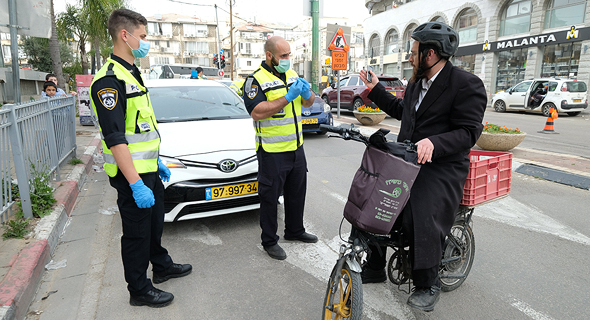Opinion
Let Our People Go (to Work)
A gradual and measured return to productivity will save the population from a recession that may be more fatal than the coronavirus disease
In most cities and towns in Israel, the morbidity rate from coronavirus (Covid-19) is low, less than one out of 1,000 residents. In contrast, there are about twenty localities suffering from a particularly high morbidity rate, particularly neighborhoods in Jerusalem and Bnei Brak, which together make up about one-third of the 12,500 afflicted patients in the country.
Localities where the rate of morbidity is less than a tenth of a percent include large cities in the Tel Aviv region, Haifa, Be'er Sheva, important employment centers such as Herzliya and Yokneam, and medium and small localities all across the country. Binyamina, Hatzor HaGlilit, Savyon and Atlit have so far recorded only two patients each. In Kfar Shmaryahu and Kfar Yasif only one patient. There are dozens of communities that have not been affected at all so far.
 Bnei Brak resident talks to policeman. Photo: Shaul Golan
Bnei Brak resident talks to policeman. Photo: Shaul Golan Hundreds of thousands of Israelis are required to stay in their homes and not stray farther than 100 meters, even though there is no real danger to them. Small businesses in these places closed shop due to indiscriminately imposed nationwide orders.
There are also very large discrepancies in the rates of infection over time. In the last two weeks, the rate has dropped in most localities, except for some of the aforementioned morbidity hot spots. In Tel Aviv in recent days, for example, only ten patients have been added on average to the list of infected. Net morbidity (the number of new infections minus the number of recoveries) is declining.
The formula for saving the economy from a fatal recession and seriously harming millions of citizens is therefore not as complicated as the people who are managing the crisis claim. On one hand, what’s required is a gradual easing of restrictions in localities where both the overall morbidity rate and the rate of infection in the last two to three weeks have been in marked decline, subject of course, to the necessary precautions. On the other hand, the state must maintain severe restrictions on all known morbidity concentrations such as the northern village of Deir al-Asad. A prerequisite for doing this must be the ability to rapidly close the loop between the appearance of symptoms and decoding infection tests, as the Gartner Institute for Epidemiology and Health, and others, have called for.
Preventing the spread of infection in workplaces is challenging, but possible. Companies, factories, and stores in hard-hit localities will have to remain closed for now. In addition, people residing in a community suffering from significant morbidity (more than one person in a thousand?) should not be allowed to come to work even if their workplace has been approved for operation. Where there is doubt, stay home.
A month and a half into the pandemic’s outbreak in Israel, the number of victims rests somewhere on the axis between the pessimistic and optimistic scenarios. Yes, it’s scary, but not apocalyptic. The damage and suffering that millions of Israelis will fall victim to if we fail to manage the overall crisis in a measured way- could be a thousand times worse.
The outline for dynamic risk management I have suggested here is, of course, theoretical and requires medical and mathematical simulations. If the ministries of health and of finance run such simulations promptly, one can hope that common sense will overcome fear.
The writer is the founder and publisher of Calcalist



